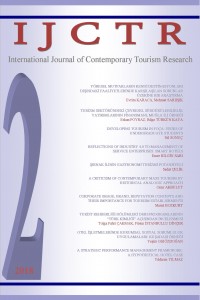Abstract
This article
underlines two historical analogic approaches as a criticism of the
contemporary mass tourism. It is argued that western hegemony developed
countries may originate contemporary mass tourism. According to historian and
classicist Kagan (2007) two complementary main features of western civilization
are Hellenism and Christianity. This article takes these complementary features
into consideration with Leiper’s (1981) Tourism System’s two main components
demand and supply. These four concepts were discussed using historical
analogies. Demand vs (versus) Christianity (heaven portrayal) were chosen as
the first analogy. Supply vs Hellenism (polis and subjects [helots] specific to
Sparta city state) was proposed as the second analogy. These two analogies may
help to gain a better understanding of mass tourism by means of a critic
approach with regard to its proposed historical roots.
References
- Hall, M. (2008). Tourism planning, policies, processes and relationships, Second edition, Pearson: UK. Hause, S. & Maltby, W. (2004). Western Civilization: A History of European Society, Wadsworth Publishing: USA.IMF (2017). World economic outlook of april 2017. www.imf.org/en/publications/weo [Access Date: 19.02.2018]Kagan, D. (2007). An introduction to ancient Greek history, Open Yale Courses, http://www.acikders.org.tr/file.php/101/Lectures/PDF/Ders04.pdf [Access Date: 19.02.2018]Leiper, N. (1981). Towards a cohesive curriculum in tourism: the case for a distinct discipline. Annals of Tourism Research, 8(11), pp. 69-84. Page, S. (2007). Tourism Management: Managing for Change Second Edition. Elsevier: Oxford. Pew Research Center (2017). The changing global religious landscape. http://www.pewresearch.org/fact-tank/2017/04/05/christians-remain-worlds-largest-religious-group-but-they-are-declining-in-europe/ [Access Date: 12.02.2018]. Pomeroy, S. B., Burstein, S. M., Donlan, W., and Roberts, J. T. (2004). A Brief History of Ancient Greece Politics, Society, and Culture, Oxford University Press: New York. Santayana, G. (1905). The Life of Reason, Prometheus Books: New York. Turkish Culture and Tourism Ministry (2018). Statistics of tourism establishments with tourism investment certificate and operation license 2016, http://yigm.kulturturizm.gov.tr/TR,9860/turizm-belgeli-tesisler.html [Access Date: 22.02.2018].UNSD (United Nations Statistics Division) (2014). Population by religion, sex and urban/rural residence. http://data.un.org/Data.aspx?d=POP&f=tableCode%3A28 [Access Date: 27.02.2018].UNWTO (United Nations World Tourism Organization) (2017). Tourism highlights 2017 edition. https://www.e unwto.org/doi/pdf/10.18111/9789284419029 [Access Date: 19.02.2018].Urry, J. & Larsen, J. (2011). The Tourist Gaze 3.0, Sage Publishing: London. http://www.datagraver.com/case/world-population-distribution-by-latitude-and-longitude-2015 [Access Date: 19.02.2018].https://dictionary.cambridge.org/tr/s%C3%B6zl%C3%BCk/ingilizce/heaven [Access Date: 26.02.2018]. https://unstats.un.org/unsd/demographic-social/products/vitstats/seratab1.pdf [Access Date: 24.02.2018].http://www.bbc.com/news/magazine-19922863 [Access Date: 06.03.2018].
Abstract
References
- Hall, M. (2008). Tourism planning, policies, processes and relationships, Second edition, Pearson: UK. Hause, S. & Maltby, W. (2004). Western Civilization: A History of European Society, Wadsworth Publishing: USA.IMF (2017). World economic outlook of april 2017. www.imf.org/en/publications/weo [Access Date: 19.02.2018]Kagan, D. (2007). An introduction to ancient Greek history, Open Yale Courses, http://www.acikders.org.tr/file.php/101/Lectures/PDF/Ders04.pdf [Access Date: 19.02.2018]Leiper, N. (1981). Towards a cohesive curriculum in tourism: the case for a distinct discipline. Annals of Tourism Research, 8(11), pp. 69-84. Page, S. (2007). Tourism Management: Managing for Change Second Edition. Elsevier: Oxford. Pew Research Center (2017). The changing global religious landscape. http://www.pewresearch.org/fact-tank/2017/04/05/christians-remain-worlds-largest-religious-group-but-they-are-declining-in-europe/ [Access Date: 12.02.2018]. Pomeroy, S. B., Burstein, S. M., Donlan, W., and Roberts, J. T. (2004). A Brief History of Ancient Greece Politics, Society, and Culture, Oxford University Press: New York. Santayana, G. (1905). The Life of Reason, Prometheus Books: New York. Turkish Culture and Tourism Ministry (2018). Statistics of tourism establishments with tourism investment certificate and operation license 2016, http://yigm.kulturturizm.gov.tr/TR,9860/turizm-belgeli-tesisler.html [Access Date: 22.02.2018].UNSD (United Nations Statistics Division) (2014). Population by religion, sex and urban/rural residence. http://data.un.org/Data.aspx?d=POP&f=tableCode%3A28 [Access Date: 27.02.2018].UNWTO (United Nations World Tourism Organization) (2017). Tourism highlights 2017 edition. https://www.e unwto.org/doi/pdf/10.18111/9789284419029 [Access Date: 19.02.2018].Urry, J. & Larsen, J. (2011). The Tourist Gaze 3.0, Sage Publishing: London. http://www.datagraver.com/case/world-population-distribution-by-latitude-and-longitude-2015 [Access Date: 19.02.2018].https://dictionary.cambridge.org/tr/s%C3%B6zl%C3%BCk/ingilizce/heaven [Access Date: 26.02.2018]. https://unstats.un.org/unsd/demographic-social/products/vitstats/seratab1.pdf [Access Date: 24.02.2018].http://www.bbc.com/news/magazine-19922863 [Access Date: 06.03.2018].
Details
| Primary Language | English |
|---|---|
| Subjects | Tourism (Other) |
| Journal Section | Original Scientific Article |
| Authors | |
| Publication Date | December 24, 2018 |
| Submission Date | October 12, 2018 |
| Published in Issue | Year 2018 Volume: 2 Issue: 2 |

